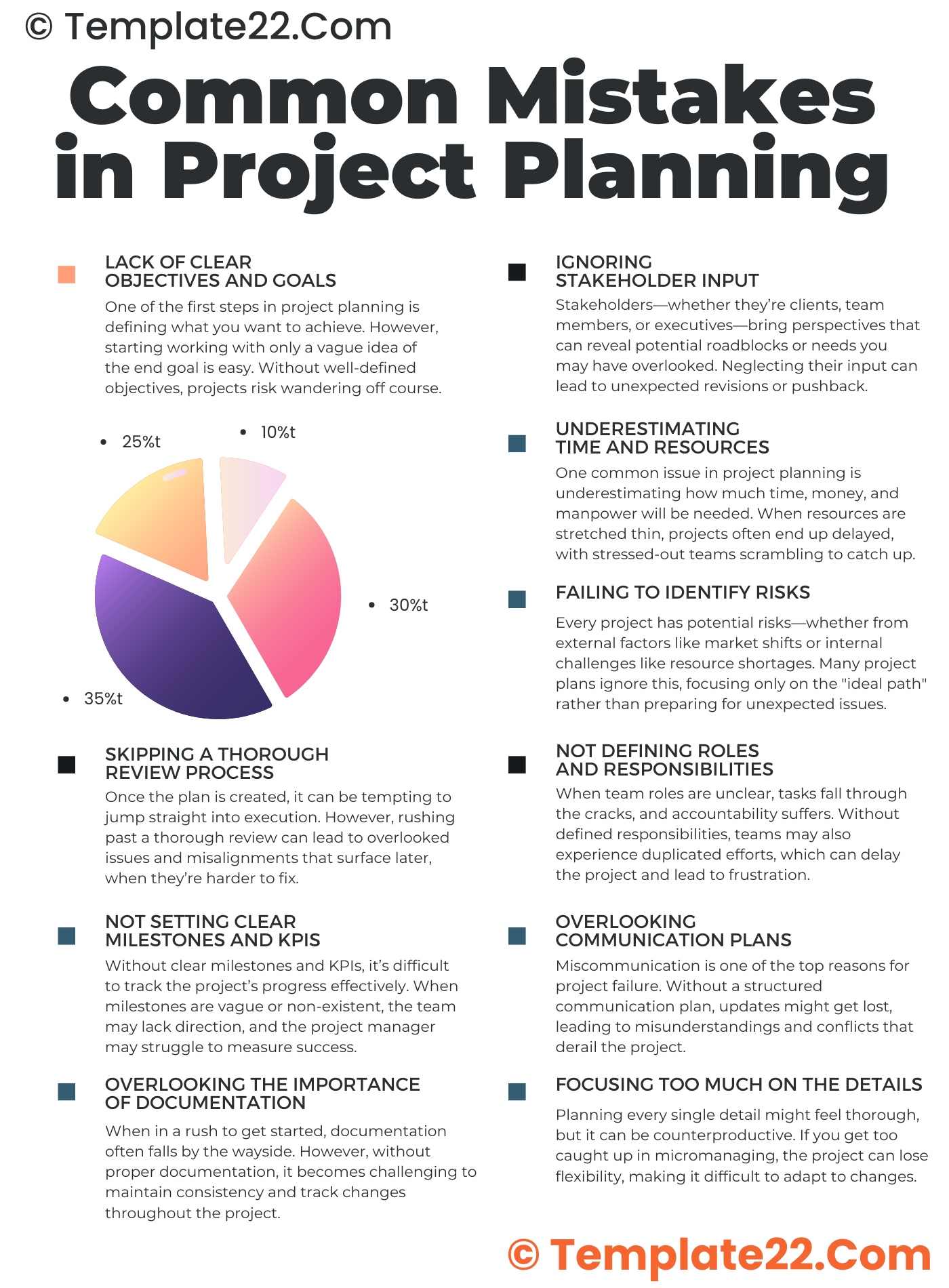 Project planning can be the backbone of success—or the reason for missed deadlines, overspent budgets, and frustrated teams. Despite their best intentions, many project managers and teams can stumble into common planning pitfalls. Here, we’ll explore Common Project Planning Mistakes and share actionable strategies to avoid them.
Project planning can be the backbone of success—or the reason for missed deadlines, overspent budgets, and frustrated teams. Despite their best intentions, many project managers and teams can stumble into common planning pitfalls. Here, we’ll explore Common Project Planning Mistakes and share actionable strategies to avoid them.
1. Lack of Clear Objectives and Goals
One of the first steps in project planning is defining what you want to achieve. However, starting working with only a vague idea of the end goal is easy. Without well-defined objectives, projects risk wandering off course.
How to Avoid This Mistake
Create specific, measurable, achievable, relevant, and time-bound (SMART) goals. Clear goals serve as a guiding star, helping your team understand what success looks like and keeping everyone aligned.
2. Ignoring Stakeholder Input
Stakeholders—whether they’re clients, team members, or executives—bring perspectives that can reveal potential roadblocks or needs you may have overlooked. Neglecting their input can lead to unexpected revisions or pushback.
How to Avoid This Mistake
Engage key stakeholders early in the planning process. Hold initial meetings to gather their feedback, understand their expectations, and incorporate their insights into your plan. This proactive communication not only strengthens your project but also builds trust with stakeholders.
CLICK HERE TO DOWNLOAD 300+ PROJECT MANAGEMENT TEMPLATES & DOCUMENTS IN EXCEL
3. Underestimating Time and Resources
One common issue in project planning is underestimating how much time, money, and manpower will be needed. When resources are stretched thin, projects often end up delayed, with stressed-out teams scrambling to catch up.
How to Avoid This Mistake
Take time to assess the full scope of the project and create realistic timelines and budgets. Break down the project into tasks and estimate the time and resources each will need. Consulting with team members who will execute the tasks can also give you a more accurate picture of what’s required.
4. Failing to Identify Risks
Every project has potential risks—whether from external factors like market shifts or internal challenges like resource shortages. Many project plans ignore this, focusing only on the “ideal path” rather than preparing for unexpected issues.
How to Avoid This Mistake
Conduct a risk assessment during the planning phase. Identify possible risks and develop contingency plans. Having a backup plan will allow your team to respond quickly and minimize disruption if problems arise. Regularly revisiting this risk assessment throughout the project can keep your team ready for any surprises.
5. Not Defining Roles and Responsibilities
When team roles are unclear, tasks fall through the cracks, and accountability suffers. Without defined responsibilities, teams may also experience duplicated efforts, which can delay the project and lead to frustration.
How to Avoid This Mistake
Create a responsibility matrix that outlines who is responsible for what. This can be as simple as assigning tasks within your project management tool or creating a RACI (Responsible, Accountable, Consulted, Informed) chart. Clarifying roles ensures that everyone knows their duties and can work efficiently.
6. Overlooking Communication Plans
Miscommunication is one of the top reasons for project failure. Without a structured communication plan, updates might get lost, leading to misunderstandings and conflicts that derail the project.
How to Avoid This Mistake
Establish a communication plan that details how information will be shared and with whom. Schedule regular meetings, define preferred communication channels, and set expectations around how quickly team members should respond. This structure will help keep everyone on the same page.
7. Focusing Too Much on the Details
Planning every single detail might feel thorough, but it can be counterproductive. If you get too caught up in micromanaging, the project can lose flexibility, making it difficult to adapt to changes.
How to Avoid This Mistake
Strike a balance by focusing on critical milestones rather than every minor detail. Use agile practices like regular check-ins and iterative planning to adjust as the project progresses. This way, your team can adapt to real-time challenges without losing sight of the bigger picture.
8. Skipping a Thorough Review Process
Once the plan is created, it can be tempting to jump straight into execution. However, rushing past a thorough review can lead to overlooked issues and misalignments that surface later, when they’re harder to fix.
CLICK HERE TO DOWNLOAD 300+ PROJECT MANAGEMENT TEMPLATES & DOCUMENTS IN EXCEL
How to Avoid This Mistake
Set aside time for a comprehensive review of the project plan. Involve key team members and stakeholders to ensure everything is clear and feasible. Address any potential gaps or ambiguities before the project officially begins. This extra step may take time, but it prevents more significant delays and challenges down the road.
Conclusion: Avoiding Planning Pitfalls for Project Success
Project planning is a crucial phase that sets the tone for the entire project’s success. By steering clear of these common mistakes—such as neglecting stakeholder input, underestimating resources, and failing to prepare for risks—you give your team a stronger foundation to build on. Taking the time to plan well ensures that your project runs smoothly, achieves its objectives, and delivers value for everyone involved.
